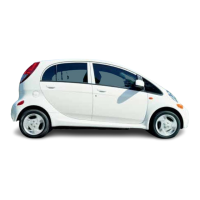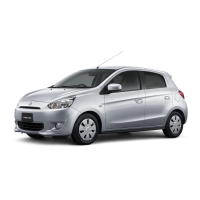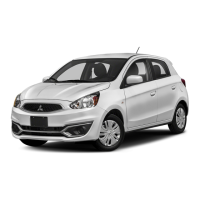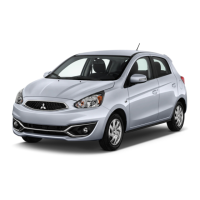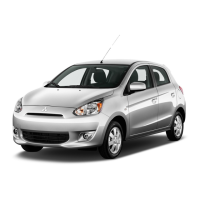Chapter 3 Cooling, heating and air conditioning systems
3-7
3 Remove the cooling fan and clutch assembly (se”e Section 5).
4 Disconnect and remove the lower radiator hose and heater hose.
5 Remove the drivebelts (see Chapter 1).
Note: To
remove the aircon-
ditioning belt, completely remove the adjustment bracket assembly.
6 Remove the cooling fan and water pump pulley.
7 Remove the alternator bracket from the water pump.
8 Remove the bolts and detach the water pump from the engine. Note
the locations of the various lengths and different types of bolts as they’re
removed to ensure correct installation
(see illustration).
Installation
9 Clean the bolt threadsand the threaded holes in the engine to remove
corrosion and sealant.
10 Compare the new pump to the old one to make sure they’re identical.
11 Remove all traces of old gasket material fr?m the engine with a gasket
scraper.
12 Clean the engine and new water pump mating surfaces with lacquer
thinner or acetone.
13 Apply a thin coat of RTV sealant to the engine side of the new gasket
and to the gasket mating surface of the new pump, then carefully mate the
gasket and the pump. Slip a couple of bolts through the pump mounting
holes to hold the gasket in place.
14 Carefully attach the pump and gasket to the engine and thread the
bolts into the holes finger tight. Note that the bolt on the left side of the
pump (that attaches the alternator brace) is longer than the other four
bolts. Be sure to install the bolt(s) with the correct length into the corre-
sponding water pump holes.
15 Place the alternator bracket in position, install the bolts and tighten all
the bolts to the torque listed in this Chapter’s Specifications in l/4-turn in-
crements. Don’t overtighten them or the pump may be distorted..
16 Reinstall all parts removed for access to the pump.
17 Refill the cooling system and check thedrivebelt tension (see Chapter
1). Run the engine and check for leaks.
2.OL;2.4L and 3,OL engines
Removal
Refer to illustration 8.28
Warning:
Wait until the engine is completely cool before beginning this
procedure.
18 Disconne,ct the negative battery cable from the battery.
19 Drain the cooling system (see Chapter 1). If the coolant is relatively
new or in good condition, save it and reuse it.
20 Remove the radiator fan shroud (see Section 4).
21 Remove the drivebelts (see Chapter 1).
22 Remove the air conditioner tensioner pulley.
23 Remove the fan and fan clutch (see Section 5).
24 Remove the water pump pulley.
25 Remove the crankshaft pulleys (see Chapter 2, Part B).
26 Remove the timing belts (see Chapter 2, Part B).
27 Remove the lower radiator hose from the water pump. If it’s stuck,
grasp it near the end with a pair of adjustable pliers and twist it to break the
seal, then pull it off. If the hose is old or deteriorated, cut it off and install a
new one.
28 Remove the boltsand detach the waterpump(see
illustration).
Note
the locations and various lengths and different types of bolts as they’re re-
moved to ensure correct installation.
Installation
29 Clean the bolt threads and the threaded holes in the engine to remove
any corrosion and sealant.
30 Compare the new pump to the old one to make sure they’re identical.
31 Removeall traces of old gasket material from the engine with a gasket
scraper.
32 Clean the engine and new water pump mating surfaces with lacquer
thinner or acetone.
33 Install a new O-ring in the groove at the front end of the coolant pipe
and lubricate the O-ring with coolant.
34 Apply a thin coat of RTV sealant to the engine side of the new gasket
and to the gasket mating surface of the new pump, then carefully mate the
gasket and the pump. Slip a couple of bolts through the pump mounting
hole to hold the gasket in place.
35 Carefully attach the pump and gasket to the engine and thread the
bolts into the holes finger tight. Be sure to install the. bolts with the correct
length into the corresponding water pump holes.
36 Tighten all bolts to the torque listed in this Chapter’s Specifications in
l/4-tumincrements. Don’tovertightenthemorthepump may bedistorted.
37 Refer to Chapter 2, part B for the installation of the timing belt(s).
38 Installation of all parts removed is the reverse of removal.
39 Refill the cooling system and check the drivebelt tension (see Chap-
ter 1). Run the engine and check for leaks.
9
Coolant temperature gauge sending unit-check
and replacement
Warning:
Wait until the engine is completely cool before beginning this
procedure.
I The coolant temperature indicator system is composed of a light or
temperature gauge mounted in the instrument panel and a coolant tem-
perature sending unit mounted on the engine. Some vehicles have more 8
than one sending unit, but only one is used for the indicator system.
2 If an overheating indication occurs, check the coolant level in the sys-
tem and then make sure the wiring between the light or gauge and the
sending unit is secure and all fuses are intact.
3 When the ignition switch is turned on and the starter motor is turning,
-___I
the indicator light should be on (overheated engine indication).
4 If the light is not on, the bulb may be burned out, the ignition switch
may be faulty or the circuit may be open. Test the circuit by grounding the
wire to the sending unit while the ignition is on (engine not running for safe-
ty). If the gauge deflects full scale orthe light comes on, replace the send-
ing’unit.
5 As soon as the engine starts, the light should go out and remain out
unless the engine overheats. Failure of the light to go out may be due to a
grounded wire between the light and the sending unit, a defective sending
unit orafaulty ignition switch. Check the coolant to make sure it’s the prop-
ertype. Plain water may have too low a boiling point to activate the sending
unit.
6 If the sending unit must be replaced, simply unscrew it from the engine
and install the replacement. Use sealant on the threads. Make sure the
engine is cool before removing the defective sending unit. There will be
some coolant loss as the unit is removed, so be prepared to catch it. Check
the level after the replacement has been installed.
10 Heating system - general information
Refer to illustrations 10. la and 10. lb
The main components of the heating system include the heater unit
(which contains the heater core and cable-operated valves) the blower
motor, the control assembly (mounted in the dash) and the air ducts which
deliver the air to the various outlet locations
(see illustrations).
’ Either outside air or interior (recirculated) air (depending on the set-
tings) is drawn into the system through the blower unit. From there the
blower motor forces the air into the heater unit.
The lever settings on the control assembly operate the valves in the
heater unit, which determines the mix of heated and outside air by regulat-
ing how much air passed through the heater core. The hotter the setting
the more air is passed through core.
The air ducts carry the heated air from the heater unit to the desired
location. Again, valves within the duct system regulate where in the ve-
hicle the air will be delivered.
The heater core is heated by engine coolant passing through it. The
heater hoses carry the coolant from the engine to the heater core and then
back again.

